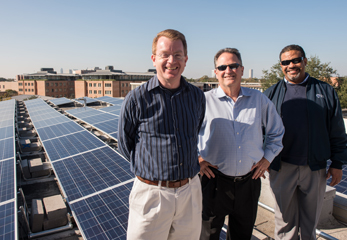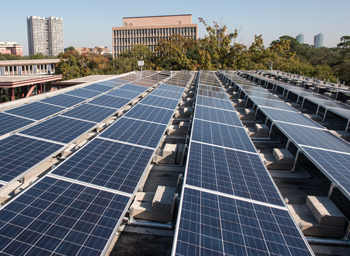A new addition to Jones College’s south wing roof is bright with promise. The final touches are being made to an installation of 186 solar panels that will produce clean energy, reduce Rice’s carbon footprint and save the university money.

Richard Johnson and Mark Ditman are joined by David Brown, senior operations manager of North Colleges, stand before the newly installed solar panels atop Jones College. Photo by Jeff Fitlow.
The 50 kilowatt solar installation will produce enough electricity each year to power six or seven typical American homes, said Richard Johnson ’92, director of Rice’s Administrative Center for Sustainability and Energy Management and professor in the practice of environmental studies in sociology. The annual greenhouse gas emission reductions associated with this clean source of energy will be about the same as taking 10 cars off the road — or the amount of carbon dioxide absorbed by almost 40 acres of forests per year, he said.
The project is the brainchild of self-described instigators Johnson and Mark Ditman, associate vice president for Housing and Dining.
“Richard’s class (Engineering Solutions for Sustainable Communities) is always looking at these sorts of projects, and as Rice built the colleges and other recent buildings, we’ve always looked at getting photovoltaics in there somehow, but they’ve always been prohibitively expensive,” Ditman said.
Johnson said Rice carefully considered including solar panels in Duncan College when it was under construction in 2008, but the cost was simply too high.
Then a couple years ago Ditman attended a conference where he heard author and energy visionary Jeremy Rifkin speak. “He really inspired me to start thinking how to use our buildings to capture solar energy,” Ditman said. “I got together with Richard, and we tried to build a case for the financial viability of putting solar panels on campus.”
“Between when we looked at photovoltaics for Duncan and now, the price has come down probably about 70 percent,” Johnson said. “It suddenly started looking a little more viable.”
A student in Johnson’s class, Sarah Southmayd ‘14, coincidentally a resident of Jones College, ended up taking the lead on what was initially a group project researching the cost of solar. “She provided valuable assistance to me to better understand how the economics for solar were becoming increasingly desirable for Rice,” Johnson said.

The 50 kilowatt solar installation, which will go "live" later this month, will produce enough electricity each year to power six or seven typical American homes. Photo by Jeff Fitlow.
He explained: The electricity market in Texas has become deregulated, so the traditional way of calculating payback on a solar panel wasn’t matching how Rice actually purchases electricity. Southmayd developed a model that was essentially calibrated for the actual price of electricity in Texas, which fluctuates greatly between day and night. There are times at night when it is almost free and then peak times in the day when it can now go to $7 per kilowatt-hour — and soon it will legally be $9, Johnson said.
And those peak moments are typically during the summer, in the mid- to late afternoon, when the Texas sun is shining brightly. If the panels are turned from facing due south to southwest — perfect because Jones College is oriented southwest — then the panels are facing the sun at the time when the electricity is most expensive.
“It’s kind of the ‘face the money’ moment,” he said. “That starts to change the economics of solar.”
They then considered an additional element that gilded the lily: The panels would also shade the building and provide a cooling effect. They found a study from University of California-San Diego that estimated the cooling effect of shading a building, and those numbers were rolled into the model as well.
“We found that the window for the payback on solar was starting to get more and more attractive, starting to get closer and closer to that 10-year mark,” Johnson said. When he had run the numbers for putting solar panels at Duncan College in 2008, payback was roughly at about the life of the panel, 25 years.
“We thought, ‘Why don’t we do a pilot project and test to see whether our model is on?'” Johnson said. They got the green light on Earth Day.
The panels are expected to go “live” later this month.

